HAILEY — Socorro Vargas de Ruiz works at a hotel in Ketchum. She wants something different for her daughters.
She wants them to have careers.
“If they go to college, they can have a career,” Vargas de Ruiz said. “They’ll have better opportunities.”
Statistics show her daughters face a tougher path than their white peers.
Across Idaho, white students outperform their Latino peers in reading, on standardized tests and in college completion. While ending this disparity is a federal goal, Idaho education leaders largely pass the responsibility for correcting this problem to school districts.
In Blaine County, where Vargas de Ruiz’ youngest daughter goes to school, outcomes are sharply uneven along ethnic and socioeconomic lines. While students in Blaine County outperform state averages, Latino youth average some 30 points below their peers on standardized tests — one of the most dramatic gaps in the state.
The district is trying to fix what they call the “opportunity gap” between white and Latino students. Under superintendent GwenCarol Holmes, leaders are rethinking traditional practices and retooling district culture to better serve an increased Latino student population.
“Basically, we are redesigning a system that was never meant to help all students succeed,” district spokeswoman Heather Crocker said in an email.
So far, results are mixed. The district has improved Latino student participation in college and career readiness classes and boosted scores among English language learners. But test scores still show a persistent gap in performance between ethnic groups, and leaders say there’s more to do if they hope to see all children achieve at a high level.
“When we continually see that some kids are learning and some kids are not learning, we are not doing our jobs,” Wood River High School Spanish teacher Erika Greenberg said.
Adjusting to demographic change in Blaine County schools
Schools in Blaine County have seen a sharp demographic shift in the past 20 years, as the share of Latino students in the Wood River Valley more than tripled. This year, 42 percent of students are Hispanic or Latino.
At times, change has stirred pushback.
In 2009, the local newspaper the Idaho Mountain Express reported that non-Latino parents were pulling students out of a local elementary school where the share of Latino students was on the rise, and some students participated in English-Spanish dual immersion.
“This is America, and we speak English,” one parent told the paper.
Ten years later, every student at that school speaks some in Spanish in class. That school, now called Alturas Elementary, transitioned into a dual immersion magnet school in 2014.
“There’s a shift happening here in our district,” said Deiysi Paredes-Monjaras, a first grade teacher at Alturas. “And it’s definitely making a lot of people uncomfortable.”
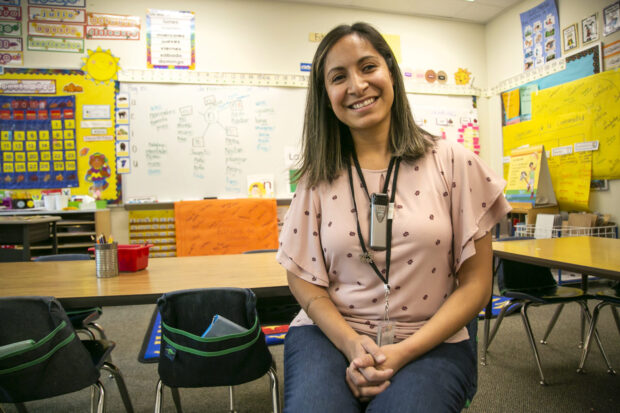
Part of that shift came at the direction of superintendent Holmes, who joined the district in 2014.
In her 2015 strategic plan, a newly appointed Holmes pointed out that Latino youth were underrepresented in advanced classes, suspended more than other students and not meeting the same benchmarks as their peers.
Holmes said the district has been using that data to “come to grips with this being the reality” in Blaine County.
“The first step is being able to own it and say: It is not OK,” Holmes said.
Since, Holmes has shifted the teaching strategy for English language learners, brought in speakers who talked about things like inequity in schools and formed a Latino staff advisory committee to help guide district leadership.
Focusing on improving Latino student achievement, Holmes said, is a way for the district to combat challenges that disproportionately affect this group, including poverty and language access.
While Latino students make up less than half of the district population overall, they make up more than 70 percent of the students living in poverty, Holmes said.
Census data shows that the median income for Latino households in the county is $20,000 less than white households, in an area with already high economic inequality.
The Mountain Express reports that Blaine County workers, who sustain the multimillion dollar mansions and glitz of Ketchum and Sun Valley, have seen wages fall to their lowest point since 2005, even as rent has continued to increase. And the Economic Policy Institute calls Blaine the “most unequal county” in the state.
That economic reality is an added burden for students like Diego Rosales.
For part of his junior year, Rosales worked three jobs to help his family pay the rent, sometimes working 30 hours on top of his Advanced Placement courseload.
“It made it so I couldn’t study,” Rosales said. “There would be times when I went in to take a test and I had no clue, because I was working the whole night before.”
Despite work, fighting homelessness, and at one point living in his car, Rosales will graduate this spring with eight AP and dual credit classes under his belt.
“What I want to do when I’m older, where I want to be, it’s just entirely different than what I’m living in,” Rosales said. “That’s overall what motivates me.”
The school district can’t change poverty, Holmes said, but it can change practices to better help students succeed.
That push for change has met some resistance both inside and outside the district, Holmes said. She’s faced denial from the “surely, that couldn’t be us,” crowd, and heard the refrain: “If we didn’t have these kids, we would be doing better.”
Recently, she thinks the district has “turned a corner,” thanks to motivated staff who have encouraged their colleagues to join the fight.
“We’ve moved beyond just grappling with ‘why is this happening to us?’” Holmes said, to: “We own this. We’re going to change it.’”
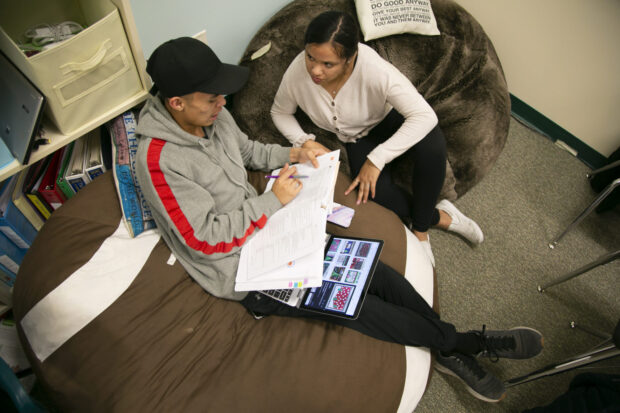
Changing district culture
Across the district, teachers and staff are evaluating if their practices are helping students learn, or perpetuating a broken system.
Teachers at Wood River High School have formed a staff-led Equity Task Force. They meet regularly to evaluate how the school’s practices can be more inclusive, and better help all students succeed.
That could mean changing policies for late homework, especially for students struggling to find time or help at home. It could also mean evaluating how they discipline students for minor offenses like being “disrespectful” — a vague concept that changes from household to household.
The English department is revamping its curriculum with student representation in mind and expanding its curriculum beyond Shakespeare and The Adventures of Huckleberry Finn. And multiple members of the task force said recruiting and retaining Latino teachers for the high school should be a district priority: Last year, only two of the school’s 73 teachers were Latino, according to state data.
“Just putting Spanish on everything doesn’t solve the gap,” task force member Sarah Allen said.
“ — Or the white privilege, or institutionalized racism,” social worker Julie Carney added.
Wood River High teacher Michel Sewell started a series of classes called GRIT (Growing Rigor, Initiative, Integrity and Tenacity), a sort of study hall intended to support students who don’t have time for classwork outside of school, need support for advanced classes or might be the first in their families to go to college. The class hosts a weekly seminar on skills like stress management, effective work habits and college and career planning. Student club Nosotros United, which students founded to bridge the cultural and academic divide at Wood River High, also holds Friday morning meetings in her classroom.
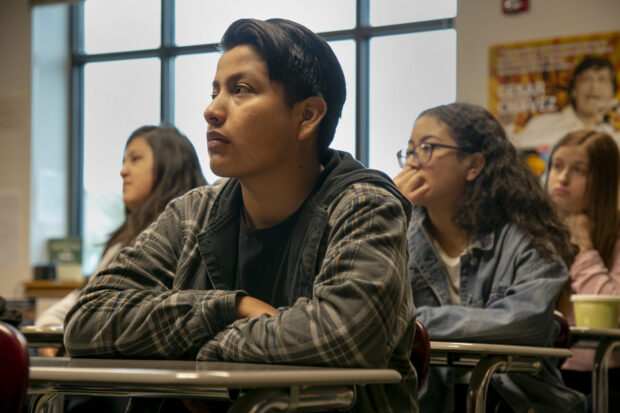
Rosales took Sewell’s class his sophomore year for extra help with his first AP class. Sewell didn’t just give him time to study, he said, she taught him to advocate for himself, sometimes by physically walking him down the hall to talk to teachers he wouldn’t have reached out to otherwise.
“Something I wouldn’t do, she’ll take you and help you do it,” Rosales said. “She will help you learn those skills you can take on later into life.”
Paredes-Monjaras, who teaches in Spanish at Alturas Elementary, said changes implemented at the district level make it easier for Latino parents to be involved in their child’s education.
Parent communication is intentional, as is scheduling of parent conferences to fit common work schedules. The district holds some meetings in Spanish with English interpretations and recently held a meeting for Spanish-speaking parents on a Saturday evening.
It all makes a difference, Paredes-Monjares said, in “letting parents know that they do have a voice.”
While the district is working to break down barriers, communication and participation remain a challenge on both sides.
Attendance was sparse at a September meeting the district hosted specifically for Spanish-speaking parents this year, where much of the discussion turned to how the district could get more parents involved.
Some parents say work remains a barrier to participating in events related to their children’s academics. And, while the district has staff who can translate for parents, one mother told reporters that she’s been frustrated with communication at Wood River High School, where her attempts to call the school in Spanish have ended with multiple unreturned voicemails.
“We need to continue to work on developing authentic, sincere and effective relationships,” Crocker said.
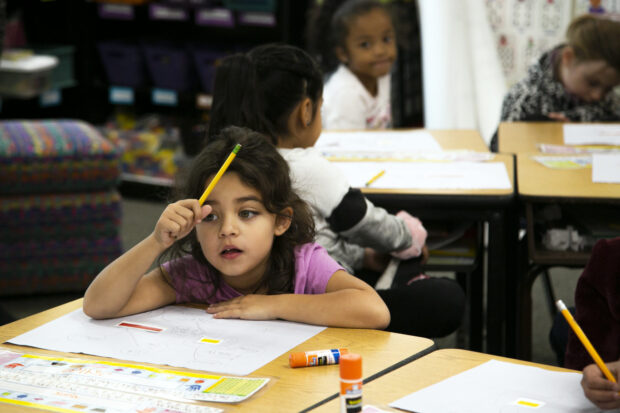
Changing outcomes one student at a time
The Blaine County district has improved the percent of Latino students participating in advanced and career-prep classes in the district. And leaders see climbing scores of English language learners as a positive sign.
Between 2014 and 2017, the district has almost closed the gap of students who are participating in at least one advanced placement or career readiness class. Part of this change could be the addition of career and technical education courses to this category, but leaders say they’ve also increased the share of Latino students in AP and dual-credit classes.
Changing those demographics was a grassroots effort. Building leaders asked teachers to make a list of the Latino students who were engaged and excited about their courses, Holmes said, then teachers volunteered to approach students about joining advanced courses.
“It was one kid at a time,” Holmes said.
Right now, Holmes says, the district is just looking at how many students are taking at least one advanced course. She suspects that white students are still graduating with more advanced courses, overall, than Latino students.
Over the past two years, proficiency for English language learners in the district has almost doubled across the board, jumping from 9.6 to 20 percent in English language arts and from 6.6 to 11.2 percent in math.
Holmes thinks a shift in the district co-teaching model played a part.
Instead of separating English language learners from their peers, as the district has done in the past, more English learners are participating in grade-level classes with the help of an additional English language specialist.
ELL teacher Tristan Ellison, for example, works with math and science teachers at Wood River Middle School to make sure their material is presented in a way that’s understandable for English language learners.
“If you assemble something, what does that mean?” she asked students as she wandered between desks in a seventh-grade science class.
She told students that a cell wall is like a frontera — a border — for the cell. And she made sure to call on the English language learners, students that can get left out if teachers don’t know how to help them participate in class.
While gains have been a positive sign for the district, they haven’t changed the drastic testing gaps between white and Latino students overall.
Math and reading proficiency among Latino students in the district has been inching up, and so too have scores for white students. But, as scores climb for both groups, the 30-point gap has moved only decimal points.
To close that gap, Holmes says, the district has to help students who are behind the curve make extra progress, instead of falling further behind.
“That is a moral obligation to me. It just weighs on me all the time,” Holmes said. “But it’s also what motivates me in what I do.”
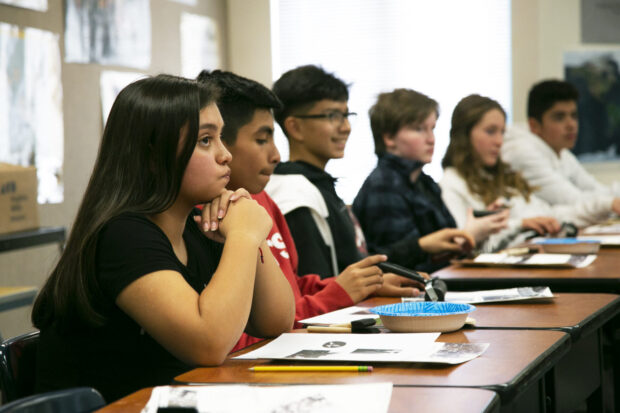
This story is part of the Latino Listening Project, an ongoing collaboration between the Idaho Statesman and Idaho Education News, focused on the educational outcomes of Latino students in Idaho. This effort is supported by the American Press Institute.
Reporters Sami Edge and Nicole Foy will be traveling the state to examine the problems — and possible solutions. Do you have an idea for them to explore or a school you think they should visit? Email [email protected] or [email protected].
Idaho Latino educators and students are also encouraged to share their stories and thoughts on our educator and student surveys.
